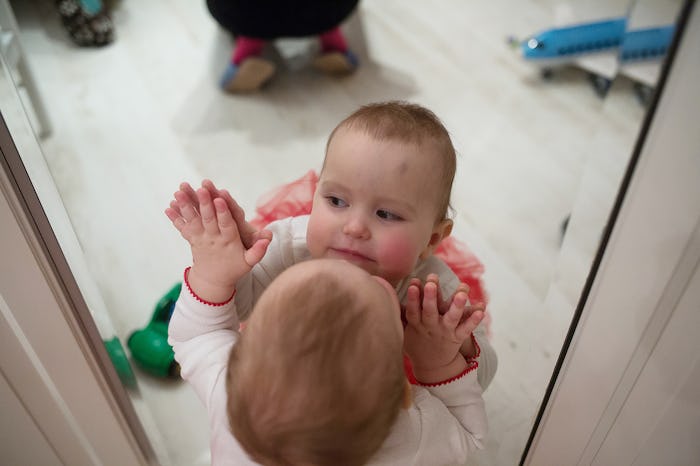Life

Here's Why Babies Love To Look At Themselves In The Mirror
A good baby toy will have multiple uses to engage a baby's five senses and work on their motor skills. That's why most infant toys have one thing in common — a mirror. Why do babies love looking at themselves in the mirror? They can't possibly know how cute they are, but there's definitely some reason they keep coming back to the looking glass.
“What the mirror does is provide something to look at that is constantly changing," pediatrician Jay Lovenheim M.D. tells Romper.
"Eventually your child will realize that the image they are seeing is responding to their own movements. It’s fun to watch your baby realize they are seeing themselves in the mirror and to watch them learn what they look like. The stimulation is also a great way to keep your child busy without electronics,” Dr. Lovenheim adds.
It could be that babies would be just as happy to look at somebody else's face in the mirror, too.
"Babies love to look at human faces, whether it’s their own or someone else’s," child development expert Jessica Rolph tells Romper.
"They especially love the faces of the people they care most about — parents, siblings, caregivers, and yes: themselves,” she continues. “Also, it’s just fun — babies adore seeing their faces look back at them, studying expressions, features, and movements.”
As far as an opportunity for learning, your baby looking in the mirror is definitely one of those times — like most things are for them at that age. “Mirrors are fantastic learning tools for a baby’s growing development and cognition, offering eye-tracking practice, chances to match you when you point to your nose (and other features), and an opportunity to hear language and vocabulary when you narrate what you’re seeing in the mirror,” Rolph says.
Additionally, mirror toys and mirrors in general also help to increase your baby's ability to focus, foster their curiosity, enhance their cognitive development, and strengthen their bodies, according to Verywell Family.
“Eyesight becomes pretty much fully functional at about 4 months old for babies,” according to Lovenheim. “That’s a perfect age to install an unbreakable mirror in a crib or play area. Between 4 and 7 months is when your child will get that sense of self identity and realize it is in fact themselves that they see in the mirror.”
It’s not until 7 months that your baby truly starts to understand their identity according to Rolph. “At around 7 months, babies start to understand that they and their mother are actually different people — up until then they believe they are one and the same. It can take close to a year for them to realize that the person in front of them in the mirror is them, not their mother,” she says. Excuse me while I go cry.
And apparently it’s not just human babies who enjoy looking at themselves in the mirror and can begin to recognize themselves. “Between 15 and 18 months, many toddlers are ready to join an extremely select group of animals who can recognize themselves in a mirror, including dolphins, elephants, and magpies," Rolph says. "It’s a big deal when they discover that they are looking at their own body, their own self — this is a critical step in developing consciousness.”
Who knew the humble mirror could provide hours of brain-boosting entertainment for babies?
Experts:
Dr. Jay Lovenheim of Lovenheim Pediatrics in West Orange, New Jersey.
Jessica Rolph co-founder and CEO of Lovevery.
This article was originally published on